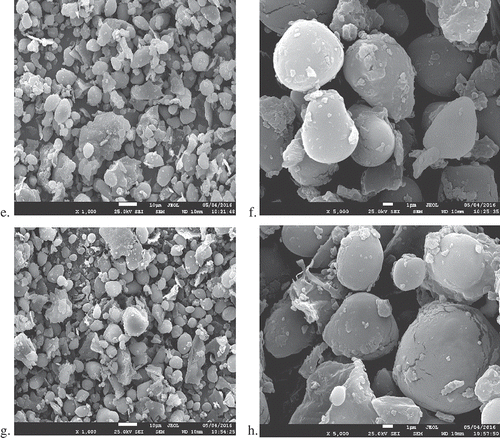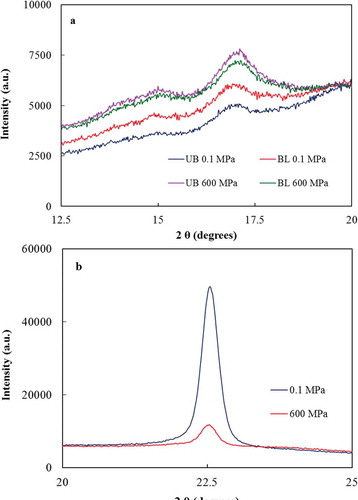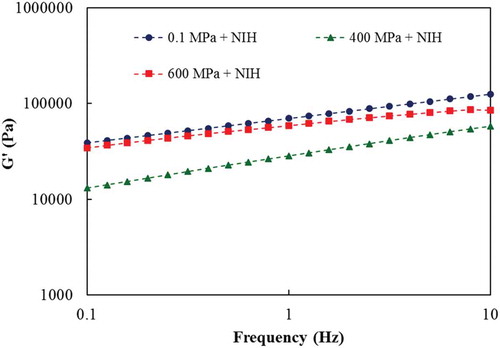ABSTRACT
Influence of high-pressure (HP) treatment (400–600 MPa, 10 min) on chestnut flour (CNF) dispersions was examined. The particle size, total starch, and resistant starch contents were not influenced by the HP treatment. DSC, XRD, SEM, and rheometric measurement confirmed that the applied pressure was not adequate for the complete gelatinization of the chestnut starch in the dispersion. The mechanical rigidity of CNF in dispersions (flour/water = 1:2) increased significantly with increasing the pressure. Pasting profiles of the HP-treated sample varied significantly from the sample without the pressure treatment. Overall, the work revealed that chestnut starch was pressure-resistant within the studied pressure range.
Introduction
Chestnut is a popular fruit, and it is consumed in many parts of the world as fresh, roasted, boiled, or dried forms. It grows in Asia (Castanea mollissima and Castanea crenata), Europe (Castanea sativa), and Eastern North America (Castanea dentata).[Citation1] The world production of the fruit was about 1.96 MT in 2010,[Citation2] and China is the largest producer of chestnuts. The fruit is enriched with starch and other valuable bioactive nutrients including vitamins (B and E), minerals (phosphorous, magnesium, and potassium), ferulic acid, caffeic acid, sinapic acid, p-coumaric acid, and salicylic acid phenolics, phytosterols, and fibre.[Citation3–Citation6]
Excess produce of chestnuts is preserved either by air drying or freezing. Dried chestnuts are ground to flour, which has tremendous potential as a food ingredient or food additive in the food and allied industries, since the major portion of the fruit contains about 50–80% of starch, and protein ranges between 6.0% and 8.6% of the dry matter.[Citation7–Citation9] Furthermore, chestnut is a good source of slowly digestible starch (SDS) and resistant starch (RS).[Citation10] Therefore, incorporation of RS in the diet influences microbial metabolism in the large intestine, and finally improves human health. Functional properties of chestnut starch can be improved through starch modification.[Citation11] Recently, chestnut flour (CNF) has attracted attention of food industries because of its gluten-free characteristics,[Citation12,Citation13] and a blend of wheat flour/CNF improved the flavour, colour, fibre, and antioxidant capacity of the bread,[Citation5] and delayed the staling after baking and storage.[Citation14]
High-pressure (HP) processing technology has been successfully employed for the development of starch-rich food products by controlling the pressure intensity with retention of the bioactive compounds. Application of HP gelatinizes starch in water dispersion, and the extent of gelatinization depends on the pressure level employed, holding time, starch to water ratio, temperature, starch type or crystallinity (A, B, or C), and the starch concentration.[Citation15,Citation16] However, the extent of gelatinization depends upon the type of starched used for the HP treatment. In general, A- or C-type starches gelatinize under the HP treatment, whereas B-type starches are pressure resistant.[Citation17] It has been reported that the HP-treated B-type starch in excess of water retained their granular shape even at 600 MPa as compared with thermal treatment, demonstrating restricted swelling ability and limited amylose release.[Citation18] Therefore, extent of starch gelatinization has a major role by influencing both textural and rheological properties of the starch-based food products. Up till now, no studies have been carried out on the effect of HP treatment on the functional, rheological, and structural properties of chestnut flour/starch.
The objective of this work was to investigate the impact of high-pressure (HP) treatment (400–600 MPa for 10 min) on chestnut dispersions, followed by functional, rheological, thermal, pasting, and structural properties evaluation of post-process freeze-dried chestnut flour samples by various analytical techniques. The outcome of the project would provide significant information on the industrial suitability or adaptability of HP-treated chestnut flour in food product development.
Materials and methods
Materials
Chinese grown chestnut (unknown cultivation) fruits (moisture content 33.9 ± 1.7% wet basis) were procured locally during the winter season of 2015–2016. Samples were washed thoroughly, peeled, and cut into small pieces with a sharp knife. Samples were ground into puree using a grinder (Hobart, OH, USA) before the pressure treatment.
Sample preparation and high-pressure treatment
Chestnut puree samples were diluted to a puree to water ratio of 1:4 (w/w) by adding required volume of distilled water, and mixed thoroughly. All puree dispersions (approximately 100 g) were packed in low-density polyethylene bags (Whirl-Pak®, USA), sealed, and placed in the pressure vessel of the HP unit (QFP 2 L-700 Avure Technologies, Kent, WA, USA). All dispersions were kept for an hour at the room temperature (25 ± 1°C) for hydration before HP treatment. Samples were pressurized (compression rate 4.2 MPa/s; decompression rate 40 MPa/s) at selected pressures (400, 500, and 600 MPa) for a holding time of 10 min. Each pressure run was carried out in duplicate. The temperature of the water (pressure-transmitting medium) before the HP treatment was 26°C, which increased to 35–38°C during pressurization from 400 to 600 MPa. After HP treatment, samples were freeze-dried (FD) (GAMMA 2–16 LSC; Martin Christ GmbH, Osterode am Harz, Germany) at a temperature between −47°C and −50°C and at a pressure of 0.7 Pa for about 48 h, and ground to powder using a coffee grinder (Braun CafeSelect KMM 30, China) for further studies on various properties. A control sample without pressure treatment (0.01 MPa) was also freeze-dried for a comparison purpose with HP-treated samples.
Proximate composition and starch analysis
The moisture, crude protein (N × 5.3), fat and ash content of CNF samples were analysed according to the AOAC method of analysis.[Citation17] Resistant starch, total starch, and damaged starch were estimated enzymatically using the Resistant Starch Assay Kit (AOAC Method 2002.02),[Citation19] total starch assay kit, and Starch Damage Assay Kit (AACC Method 76–31.01), respectively.[Citation19]
Water and oil holding capacity
The water holding capacity (WHC) and oil holding capacity of the CNF samples were determined as per method described by McConnell, Eastwood, and Mitchell[Citation20] and Caprez, Arrigoni, Amado, and Neukom,[Citation21] respectively at 25°C. The volume fraction of the chestnuts flour was measured using a simple centrifugation method.[Citation12]
Particle size distribution
The particle size distribution (PSD) of the HP-treated and control samples was measured by a laser diffraction particle size analyser (Mastersizer 3000, Malvern Instruments Ltd., UK) using Hydro EV Flexible volume wet dispersion. For the particle size measurement, the refractive indices of 1.31 for water and 1.52 for CNF were used as the standard. The PSDs, that is, particle size at 10% (Dv10), 50% (Dv50) (median diameter), and 90% (Dv90) of the volume distribution were all obtained from the instrument software.
Scanning electron microscopy
The microstructures of CNF particles were observed through a scanning electron microscope (SEM) (JEOL, JSM-5410LV, Tokyo, Japan) following the method described by our earlier publication on CNF.[Citation1] Each sample was coated with gold in a sputter coater (Structure Probe, West Chester, PA, USA) before being scanned and photographed at various magnifications (1000× and 5000×).
Instrumental colour measurement
Visual colour was measured using a Hunter colorimeter model ColorFlex (Hunter Associates Laboratory, Reston, VA, USA) in terms of L (lightness), a (redness and greenness), and b (yellowness and blueness) as described earlier by Ahmed and Al-Attar.[Citation12] The instrument (45°/0° geometry, 10° observer) was calibrated with a standard black and white tile followed by measurement of samples.
Thermal properties measurement
Thermal analysis of CNF dispersions in aluminium pans (10–12 mg) was carried out using a differential scanning calorimeter (DSC) (TA Q 2000, TA Instruments, New Castle, DE, USA) under dry nitrogen environment. The samples were heated from −20°C to 150°C at a heating rate of 10°C/min to detect thermal properties, including gelatinization of starch and protein denaturation using the Universal Analysis Software (version 4.5A, TA Instruments).
Rheological measurement
Oscillatory rheology of CNF doughs [flour to water (F/W) ratio 1:2] was carried out by a Discovery Hybrid Rheometer HR-3 (TA Instruments) within the linear viscoelastic range (LVR). It is worth mentioning that samples containing F/W ratio of 1:3 and 1:4 were not suitable for rheological measurement for its watery nature. Samples were placed in a 1500 μm gap between two stainless steel parallel plates (plate diameter 40 mm) which was equipped with peltier system. The edge of the sample was covered with a thin layer of silicone oil to prevent moisture evaporation. Both control and HP-treated samples were heated from 25°C to 95°C at a heating rate of 5°C/min at a constant frequency of 1 Hz to ascertain the extent of gelatinization and the peak gelatinization temperature during the pressure treatment. Frequency sweep tests (0.1–10 Hz) of HP-treated samples were carried out in the LVR range at constant strain (0.1%) before and after non-isothermal heating at 25°C as described earlier by Ahmed and Thomas.[Citation22] All rheological parameters were obtained directly from the manufacturer supplied computer software (TRIOS, TA Instruments).
Pasting properties
The pasting properties of chestnut flour dispersions (15 g of chestnut flour/100 ml distilled water) were measured by a Micro-Visco-AmyloGraph (Brabender, Duisburg, Germany) using the method described by Ahmed and Al-Attar[Citation12] for chestnut flour samples. Pasting parameters including pasting temperature, peak viscosity, hold viscosity, breakdown viscosity, final viscosity, and setback viscosity were obtained from the instrumental software.
X-ray diffraction analysis
X-ray diffraction analysis of the selected flours was performed using a diffractometer Bruker D8 Advance (Bruker AXS, Germany) equipped with monochromatic Cu-Kα radiation (λ = 0.154 nm) under a voltage of 40 kV and a current of 40 mA. All samples were analysed in continuous scan mode with 2θ ranging from 5° to 80°.
Statistical analysis
All measurements were carried out in triplicates and average values are reported. The regression analysis, analysis of variance (ANOVA), of data was carried out using the Minitab Statistical Software (version 16; Minitab Corp., USA). For statistical tests, significance was defined at p ≤ 0.05.
Results and discussion
Physicochemical properties
Proximate analysis of CNF indicated that the moisture, the ash, and the protein contents were not significantly (p > 0.05) influenced by HP treatment. The moisture contents remained below 1.5% (dry basis), whereas the ash and protein contents ranged from 1.8% to 2% and 7.5% to 7.8%, respectively. The crude fat contents increased from 0.4% to 0.79% with increasing pressure from 0.1 to 600 MPa. The reason for such an increase is not clear.
Effects of HP treatment on physicochemical and functional properties of CNF are presented in and . The total starch content decreased insignificantly (p > 0.05) from 47.3% to 46.1%, and the damaged starch remained below 1% after HP treatment (). It has been observed that CNF contains a high amount of RS (≈36%), and is well supported by the earlier report.[Citation23] The RS values of CNF were mostly unaffected by the pressure treatment. In our earlier work on HP treatment of lentil starch, a significant increase in RS at 600 MPa was detected.[Citation15] It indicates that the RS which formed crystallites by forming the strong interactions between amylose–amylose and/or amylose–amylopectin chains within native chestnut starch granules remained unaffected under HP.
Table 1. Effect of high-pressure treatment on starch properties of chestnut flour samples.
Table 2. Effect of high-pressure treatment on functional properties of HP-treated chestnut flour samples.
HP treatment marginally changed the instrumental colour values. The lightness, L, values did not change significantly with the intensity of pressure. Both redness, +a, and yellowness, +b, colour values increased insignificantly from 2.60 to 2.72 and 13.37 to 13.60, respectively, when the pressure increased from 0.1 to 600 MPa. Such increase in marginal colour values could be associated with change in pigments, especially carotenoids after the HP treatment.
Water holding capacity, solubility index, and volume fraction
The WHC of CNF decreased initially at 400 MPa measured at 25°C, and increased thereafter, up to 600 MPa (p < 0.05), although the value still remained below the control sample (). The WHC increased significantly at 70°C due to swelling of the chestnut starch molecules at elevated temperature, and followed a similar trend with HP-treated samples as observed at 25°C. This observation is contrary to our earlier work on β-glucan concentrate[Citation24] where the WHC increased with the intensity of pressure. A drop in WHC values might be attributed by the decrease or at least maintaining the surface area of particles after pressurization. The water solubility index (WSI) of pressurized sample increased with increasing pressure levels at 25°C, whereas no significant change was observed at 70°C which is also attributed by presence of uniform particle sizes. The sediment volume fraction, ф, of the CNF samples both at 25°C and 70°C changed insignificantly with the intensity of the pressure, whereas ф increased significantly at elevated temperature due to excessive swelling of starch granules.
SEM and particle size distribution
Scanning electron micrographs of chestnut flours (1000× and 5000×) subjected to different pressure treatments are illustrated in . Native chestnut starch was found to be composed of various shapes of granules including round- and oval-shaped with smooth surface. These results are consistent to those reported earlier by Hu et al.[Citation25] for chestnut starch, whereas some other shapes including irregular and triangular have been reported for chestnut starches.[Citation26] However, presence of some amount of other materials, like fibres and proteins, are also observed in addition to starch granules. Correia et al.[Citation27] described such observation (starch, protein, and fibres) of dried chestnuts as a “raising dust” appearance. The surface morphology of chestnut starch was not influenced by pressure treatment. The surface of starch granules appeared to be smooth and showed a minor crack after 600 MPa (). The starch granules retained their microstructure and structural integrity because of the incomplete gelatinization of chestnut flour after pressure treatment. Our findings revealed that the effect of HP on chestnut starch morphological properties was pressure independent.
Figure 1. Micrographs of high-pressure treated chestnut samples at selected pressures at magnifications of 1000× and 5000×: (a) 0.1 MPa, 1000×; (b) 0.1 MPa, 5000×; (c) 400 MPa, 1000×; (d) 400 MPa, 5000×; (e) 500 MPa, 1000×; (f) 500 MPa, 5000×; (g) 600 MPa, 1000×; and (h) 600 MPa, 5000×.
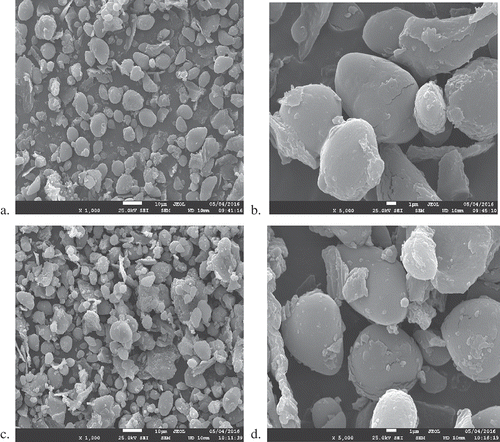
The PSD of pressure-treated CNF samples are shown in . All samples exhibited distinct bimodal PSD (data not shown). The particle size recorded at Dv10 (4.7–4.8 μm) and Dv50 (30–36 μm) did not show any pressure effect, whereas the Dv90 showed a significant decrease in particle size from 261 to 248 μm after a pressure treatment of 600 MPa. The decrease could be associated with the excessive pressure followed by FD, where particles became partially fragile and disintegrated.
X-ray diffraction patterns
shows the X-ray diffraction (XRD) patterns of the CNF before and after pressure treatment. Chestnut starch showed single peaks at diffraction angles of 15° and 17° at 2θ, and a double peak between 22.5° at 2θ, which is close to characteristic of B-type polymorphism, although we could not trace a peak at 5°, indicating that freeze drying disrupted the B-type crystallites of chestnut starches, presumably by damaging the long-range order of double helices due to the loss of bound water between/within double helices.[Citation25] With the increase of pressure intensity, the diffraction peaks at 15° and 17° 2θ were more pronounced, whereas the peak at 22.5° reduced its intensity at 600 MPa. The absence of 20° 2θ peak indicated that there was no more crystalline amylose–lipid complexes formation in the studied samples either before or after HP treatment. Our observations confirmed the pressure resistance of chestnut starch. Earlier researchers reported chestnut starch as both type-B and type-C because of some overlapping.[Citation7,Citation25,Citation28]
Differential scanning calorimetry
The peak of the melting endotherm crystals (Tp) as obtained by DSC measurements are reported in .
Table 3. Effect of high-pressure treatment on gelatinization properties of HP-treated chestnut flour samples.
The Tp of chestnut starch without pressure treatment was detected at 67.4°C, and the value increased insignificantly with pressure treatment. The maximum value was recorded at 68.4°C after pressure treatment at 600 MPa. The obtained Tp values are in agreement with previous results in chestnuts.[Citation7] An increase in DSC melting temperatures during pressurization of starch in water suspensions indicates the loss of the less stable crystalline structures.[Citation29] A gradual drop in the fusion enthalpy of chestnut starch crystallites during HP treatment indicated gradual gelatinization with increasing the pressure intensity. The residual enthalpy at 600 MPa confirmed the incomplete gelatinization of chestnut starch. In addition to gelatinization peak, a second thermal transition was detected between 106°C and 108°C (data not shown), which is believed to be associated with the protein denaturation of CNF (control). Application of a pressure level of 600 MPa could not able to denature the protein as observed through a high residual enthalpy values (8–11 J/g). The protein denaturation temperature (Td) of the HP-treated CNF samples, however, varied non-systematically from 102°C to 110°C.
Rheological characteristics
Comparisons of mechanical properties of CNF doughs between HP treatment at 600 MPa and without treatment are illustrated in . It can be seen that the elastic (G′) and the viscous (G″) modulus of both CNF doughs increased with the increasing frequency, and displayed a solid-like or weak-gel behaviour (G′ > G″). Both moduli increased significantly as the pressure was increased from 0.1 to 600 MPa. However, the increment of G″ was relatively higher than the G′ at 600 MPa, which indicates a slow development in the mechanical rigidity of the dough. Furthermore, the increase of G′ after 600 MPa was significantly lower than that of observed for rice or lentil starch doughs.[Citation15,Citation30] All those cases, the starch was completely gelatinized; the developed gel was stronger and the increase of G′ was few log cycles higher compared with the control sample. However, in the present study, the starch was not completely gelatinized as discussed earlier, and the resultant gel became weaker (discussed later). The change of viscoelasticity of HP-treated sample was significantly different from the control sample as indicated by the phase angle (δ) (). It indicates a change in material property after pressurization, however it deviates from an ideal gel where the δ is independent of frequency.
Figure 3. (a) Comparison of mechanical behaviour between untreated and high-pressure-treated chestnut dispersions; (b) effect of pressure on complex viscosity of chestnut dispersions at 25°C.
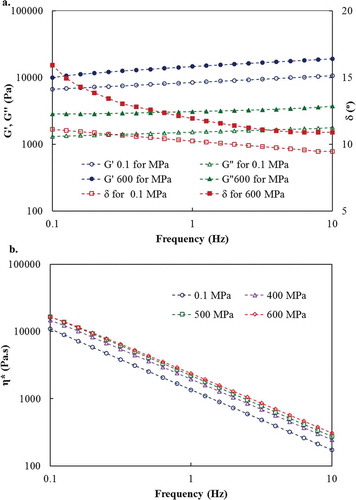
The mechanical properties of CNF dough samples increased gradually with increasing pressure intensity as shown in . The η* increased significantly after pressure treatment at 400 MPa over the control sample, however the η* values of sample treated at 600 MPa are insignificantly higher than that of sample treated at 500 MPa. The solid-like property of HP-treated CNF dough decreased with increasing the pressure level as indicated by the slope of ln G′ versus ln ω. The slope increased from 0.10 to 0.13 when the pressure intensity increased from 0.1 to 600 MPa, and it indicated the HP-treated sample transformed from solid-like to liquid-like state.
DSC measurement indicated that the chestnut starch was not completely gelatinized by the HP treatment, and therefore, an attempt was made to identify the residual gelatinization peak during non-isothermal heating of the HP-treated dough sample from 35°C to 95°C (). The complex viscosity, η* for dough samples decreased gradually as the heating proceeds from 35°C to 63°C, and increased sharply thereafter, and followed the same trend. An abrupt increase in η* was observed on further heating with a peak value at about 72–74°C. The heating pattern of HP-treated doughs followed a similar pattern as exhibited by the sample without pressure treatment. Increased η* values in the thermogram indicated that the extent of maximum possible gelatinization of the amorphous fraction of CNF starch occurred at 600 MPa, and therefore, improved the mechanical rigidity. The peak temperatures in the thermograms indicated the gelatinization of chestnut starch by melting the amylopectin crystallites which remained incomplete after HP treatment. It has been reported that the degree of the crystalline structure melting under HP depends on the amylose to amylopectin ratio, and type of starches (type A, B, or C). Such pressure resistance of chestnut starch gelatinization has been supported by DSC, SEM, and XRD as discussed earlier. It has been reported that the pressure resistance shown by starches are attributed by a far greater level of ordered structure in the external region of the granule and different structure of the external region of the starch granules, and furthermore, a complete gelatinization was achieved in potato and RS only at the higher pressure range of 600–800 MPa.[Citation31]
Figure 4. Evolution of complex viscosity of chestnut dough samples during non-isothermal heating as influenced by intensity of pressure.
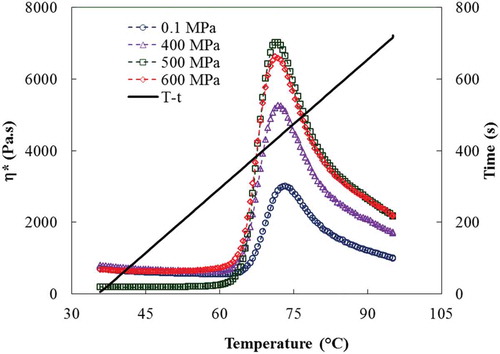
A comparison of the mechanical rigidity (G′) shown by HP-treated CNF dough samples (400 and 600 MPa) followed by non-isothermal heating to 95°C, and cooling to 25°C against a control sample underwent a similar heating/cooling steps in the frequency range of 0.1–10 Hz is shown in . It can be seen that the sample without pressure treatment exhibited the highest mechanical strength compared with the HP-treated samples even after 600 MPa. HP treatment possibly affects the starch granules differently during gelatinization process which could not produce a stronger or equal gel strength on further heating as produced by the non-pressurized sample. It indicates the gel strength mechanisms by the two processes are different from each other.
Viscoamylograph analysis
The pasting profiles including peak viscosity (PV), cold paste viscosity (CPV), hot paste viscosity (HPV), breakdown (BD), final viscosity (FV), setback (SB), peak time (PT), and pasting temperature (PT) of the control (untreated) and HP-treated CNF are presented in . A significant difference was observed in the pasting properties between control and HP-treated samples. The peak viscosity which is the highest value of viscosity attained by the slurry during the heating cycle decreased from 1087 to 1026 BU when the pressure intensity was increased from 0.1 to 600 MPa. It indicates about the partial gelatinization of starch granules during the HP treatment. Additionally, the reduction in PV following HP treatment largely results from restricted swelling of starch granules. The temperature and time corresponding to PV which is known as the peak temperature and peak time increased insignificantly with the pressure treatment. The pasting temperature where the first detectable viscosity is obtained changed insignificantly with pressurization. The results of pasting temperature are in accordance to the reported values.[Citation23]
Table 4. Effect of high-pressure treatment on pasting properties of HP-treated chestnut flour dispersions.
The HPV, which indicates the fragility of the swollen granules towards shear, increased with the intensity of pressure treatment. CPV of HP-treated samples decreased with the pressure intensity, which indicates a drop in the retrogradation tendency of the soluble amylose after cooling. The final and setback viscosities provide information on the retrogradation behaviour of starch gels. The final viscosity decreased at 500 MPa, and increased thereafter. The breakdown viscosity (BDV) values decreased with the pressure treatment. The observed high BDV values indicate a higher degree of starch granule destruction. The reduction in BD might also be attributed to the limited granular swelling.[Citation7] The negative magnitude of SBV indicated a marked reduction in amylose leaching that restricted crystallization/recrystallization after cooling in the HP-treated CNF. The absence of retrogradation could be associated with disordered system, where formation and subsequent aggregation of double helices were hindered after heating of HP-treated samples.
Conclusion
The present study has provided some insights into the impact of HP treatment on starch-rich chestnut flour in dispersions. At pressure range of 400–600 MPa, the chestnut starch in the dispersion is able to gelatinize completely as evidenced from various analytical techniques, and it is believed that the type of starch structure could be the reason for the pressure resistance. Starches including RS and total starch, granules particle size, and hydration properties remained unaffected by HP treatment. The pasting properties of HP-treated chestnut flours were different from those of native flour, specifically in the values of peak, hot paste, breakdown, and setback viscosities. The solid-like property of the untreated CNF dough dropped with HP treatment, and the process enthalpy decreased with increasing the pressure intensity. A combination of pressure/temperature or a higher intensity of pressure could break the starch crystallites adequately to complete the starch gelatinization process. The obtained results could be useful for the development of chestnut-based gluten-free food product.
Acknowledgment
Authors appreciate the help of Dr. Antony Joseph for XRD analysis.
Funding
The authors acknowledge the financial support from the Kuwait Institute for Scientific Research (FB 098K).
Additional information
Funding
References
- Barakat, A.; DiLoreto, D.S.; Zhang, Y.; Smith, C.; Baier, K.; Powell, W.A.; Wheeler, N.; Sederoff, R.; Carlson, J.E. Comparison of the Transcriptomes of American Chestnut (Castanea dentata) and Chinese Chestnut (Castanea mollissima) in Response to the Chestnut Blight Infection. BMC Plant Biology 2009, 9, 51–57.
- FAOSTAT. http://faostat.fao.org/site/339/default.aspx. 2012.
- Borges, O.P.; Soeiro Carvalho, J.; Reis Correia, P.; Paula Silva, A. Lipid and Fatty Acid Profiles of Castanea sativa Mill. Chestnuts of 17 Native Portuguese Cultivars. Journal Food Compos Analysis 2007, 20, 80–89.
- Kim, J.Y.; Kimg, S.Y.; Kwon, H.M.; Kim, C.H. Comparison of Antioxidant and Anti-Inflammatory Activity on Chestnut, Chestnut Shell and Leaves of Castanea crenata Extracts. Korean Journal Medicinal Crop Sciences 2014, 22, 8–16.
- Paciulli, M.; Rinaldi, M.; Cirlini, M.; Scazzina, F.; Chiavaro, E. Chestnut Flour Addition in Commercial Gluten-Free Bread: A Shelf-Life Study. LWT - Food Science and Technology 2016, 70, 88–95.
- Pereira-Lorenzo, S.; Ramos-Cabrer, A.M.; Dıaz-Hernandez, M.B.; Ciordia-Ara, M.; Rıos-Mesa, D. Chemical Composition of Chestnut Cultivars from Spain. Scientia Horticulture 2006, 107, 306–314.
- Liu, H.; Guo, X.; Li, Y.; Li, H.; Fan, H.; Wang, M. In Vitro Digestibility and Changes in Physicochemical and Textural Properties of Tartary Buckwheat Starch under High Hydrostatic Pressure. Journal of Food Engineering 2016, 189, 64–71.
- Míguelez, J.M.; Bernárdez, M.M.; Queijeiro, J.M.G. Composition of Varieties of Chestnuts from Galicia (Spain). Food Chemistry 2004, 84, 401–404.
- Moreira, R.; Chenlo, F.; Torres, M.D.; Rama, B. Influence of the Chestnuts Drying Temperature on the Rheological Properties of Their Doughs. Food and Bioproducts Processing 2013, 91, 7–13.
- Pizzoferrato, L.; Rotilio, G.; Pai, M. Modification of Structure and Digestibility of Chestnut Starch upon Cooking: A Solid State 13C CP MAS NMR and Enzymatic Degradation Study.Journal of Agricultural Food Chemistry 1999, 47, 4060–4063.
- Lutfi, Z.; Nawab, A.; Alam, F.; Hasnain, A., Morphological Physicochemical, and Pasting Properties of Modified Water Chestnut (Trapabispinosa) Starch. International Journal of Food Properties 2016. doi:10.1080/10942912.2016.1193514.
- Ahmed, J.; Al-Attar, H. Effect of Drying Method on Rheological, Thermal, and Structural Properties of Chestnut Flour Doughs. Food Hydrocolloids 2015, 51, 76–87.
- Ahmed, J.; Al-Attar, H.; Arfat, Y.A. Effect of Particle Size on Compositional, Functional, Pasting and Rheological Properties of Commercial Water Chestnut Flour. Food Hydrocolloids 2016, 52, 888–895.
- Rinaldi, M.; Paciulli, M.; Dall’Asta, C.; Cirlini, M.; Chiavaro, E. Short-Term Storage Evaluation of Quality and Antioxidant Capacity in Chestnut–Wheat . Bread Journal of the Science of Food & Agriculture 2015, 95, 59–65.
- Ahmed, J.; Thomas, L.; Taher, A.; Joseph, A. Impact of High Pressure Treatment on Functional, Rheological, Pasting, and Structural Properties of Lentil Starch Dispersions. Carbohydrate Polymers 2016, 152(5), 639–647.
- Kawai, K.; Fukami, K.; Yamamoto, K. State Diagram of Potato Starch-Water Mixtures Treated with High Hydrostatic Pressure. Carbohydrate Polymers 2007, 67, 530–535.
- Bauer, B.A.; Knorr, D. TheImpact of Pressure, Temperature and Treatment Time on Starches: Pressure-Induced Starch Gelatinisation as Pressure Time Temperature Indicator for High Hydrostatic Pressure Processing. Journal of Food Engineering 2005, 68, 329–334.
- Douzals, J.P.; Perier Cornet, J.M.; Gervais, P.; Coquille, J.C. High-Pressure Gelatinization of Wheat Starch and Properties of Pressure-Induced Gels. Journal of Agricultural and Food Chemistry 1998, 46, 4824–4829.
- AOAC. Official Methods of Analysis (18th ed.); Association of Official Analytical Chemists: Arlington, VA, 2005.
- McConnell, A.A.; Eastwood, M.A.; Mitchell, W.D. Physical Characteristics of Vegetable Foodstuffs that Could Influence Bowel Function. Journal of the Science of Food and Agriculture 1974, 25, 1457–1464.
- Caprez, A.; Arrigoni, E.; Amado, R.; Neukom, H. Influence of Different Types of Thermal Treatment on the Chemical Composition and Physical Properties of Wheat Bran. Journal of Cereal Science 1986, 4, 233–239.
- Ahmed, J.; Thomas, L. Effect of Β-Glucan Concentrate on the Water Uptake, Rheological and Textural Properties of Wheat Flour Dough. International Journal of Food Properties 201518, 1801–1816.
- Correia, P.; Cruz-Lopes, L.; Beirão-da-Costa, L. Morphology and Structure of Chestnut Starch Isolated by Alkali and Enzymatic Methods. Food Hydrocolloids 2012, 28, 313–319.
- Ahmed, J.; Thomas, L.; Arfat, Y.A. Effects of High Hydrostatic Pressure on Functional, Thermal, Rheological and Structural Properties of Β-D-Glucan Concentrate. LWT - Food Science and Technology 2016, 70, 63–70.
- Hu, N.; Gu, X.; Li, L.; Ouyang, J.; Wang, F.; Wang, J.; Fan, Z. Synthesis and Evaluation of Microstructure of Phosphorylated Chestnut Starch. Journal of Food Process Engineering 2014, 37, 75–85.
- Wang, S.; Liu, C.; Wang,S. Drying Methods Used in Starch Isolation Change Properties of C-Type Chestnut (Castanea mollissima) Starches. LWT - Food Science and Technology 2016, 73, 663–669.
- Correia, P.; Leitão, A.; Beirão-da-Costa, M.L. The Effect of Drying Temperatures on Morphological and Chemical Properties of Dried Chestnuts Flours. Journal of Food Engineering 2009, 90, 325–332.
- Yang, B.; Jiang, G.; Prasad, K.N.; Gu, C.; Jiang, Y. Crystalline, Thermal and Textural Characteristics of Starches Isolated from Chestnut (Castanea mollissima Bl.). Seeds at Different Degrees of Hardness. Food Chemistry 2010, 119, 995–999.
- Katopo, H.; Song, Y.; Jane, J. Effect and Mechanism of Ultrahigh Hydrostatic Pressure on the Structure and Properties of Starches. Carbohydrate Polymers 2002, 47, 233–244.
- Ahmed, J.; Mulla, M.Z.; Arfat, Y.A., Kumar, V. Effects of High-Pressure Treatment on Functional, Rheological, Thermal and Structural Properties of Thai Jasmine Rice Flour Dispersion. Journal of Food Processing and Preservation 2016. DOI:10.1111/jfpp.12964 (Published online).
- Sevenou, O.; Hill, S.; Farhat, I.A.; Mitchell, J.R. Organization of the External Region of the Starch Granule as Determined by Infrared Spectroscopy. International Journal of Biological Macromolecules 200231, 79–85.

